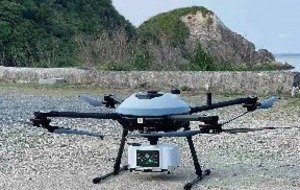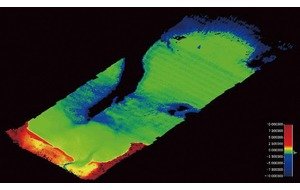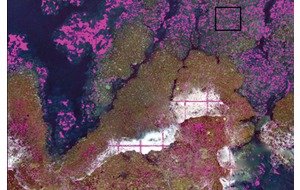Major Research 3A Research on Development and Utilization of Oceans
Background and Objectives
Since the 1960s, the importance of marine utilization and development has been pointed out. Various approaches for this purpose have been taken, but the progress remains inadequate. One of the reasons is the lack of infrastructure at sea as a hub. Therefore, marine hub ports should be constructed on remote islands including Minamitorishima Island and Okinotorishima Island to promote marine utilization and development. These remote islands are surrounded by severe sea wave environment and severe sea climate for port construction which are different from those of general ports in main islands. Further technological development is required to ensure smooth ship berthing, cargo-handling, and port construction. Therefore, in this research theme, we will make maximum use of previously accumulated knowledge regarding waves, sea-bed soils, port structures, and port construction to construct ports on remote islands, and will also promote marine utilization and development. Specifically, we will clarify the characteristics of waves in isolated reef areas, and will develop a new mooring system for ships. We will also develop technologies for downsizing and reducing the weight of underwater acoustic video cameras, as well as utilization and development.
Research Topic
Research and development are being conducted on the following subjects for the development and utilization of oceans.
For our development of analytical methods applicable to the topographic dynamics of carbonate remote islands, we analyzed the processes and mechanisms of topographical change and ground formation and verified the validity of our survey and analysis techniques. Based on our findings, we proposed effective methods of surveying and analyzing low-water lines, shorelines, and other topographical features near port facilities, with a view to their preservation.
For our research on the equipment of underwater construction machines with multiple functions using machine guidance technology, we used profile sonar to conduct an experiment on its external measurement, tested the accuracy of our acoustic positioning system, and developed a remote operation support system.
For our research on the acoustic imaging system, we explored ways to install acoustic video cameras on a work vessel, and worked on developing a software program that would enable real-time monitoring of an ongoing construction project.
For our research on the horizontal resistance characteristics of pile foundations at offshore wind power plants, we performed horizontal cyclic loading tests on piles along with related element tests, worked on enhancing our numerical analysis code for simulating the process of pile penetration, and examined our non-linear spring model of soil that factored in horizontal cyclic loading.
For our research on the mechanical properties and durability of various infrastructure materials in the deep sea, we designed and produced related testing equipment, and performed durability experiments in a high-pressure water tank using a low-temperature seawater circulation system. We also started conducting an exposure experiment on infrastructure materials in the deep sea, etc.
Activities in FY 2020
For the development of a fender system for automatic ship berthing/unberthing, we invented a fender system that has adsorption pads fixed to the front of the fender panel on the fenders to allow automatic and efficient ship berthing/unberthing and also to enable steady mooring and cargo-handling operations. In addition, we studied the optimal adsorption pad structure that could easily cling to the side of a ship, and also examined a prior study on the conceptual structure of a vertical adjuster mechanism that would track a ship's movement along with a change in its draft, which allowed us to create the basic concept of our fender system for automatic ship berthing/unberthing.
For our development of analytical methods applicable to the topographic dynamics of carbonate remote islands, we were able to achieve the following. We succeeded in developing a monitoring method that combined images shot by drones and stationary cameras and survey data to observe the entire low-water lines and shorelines of remote islands as well as the topographic changes occurring around port facilities. We conducted an on-site experiment on Iriomote Island in Okinawa Prefecture to prove the method's effectiveness. We also developed a method that could automatically determine the distribution and activity levels of reef-forming organisms using aerial photography, AI, etc.

Hybrid drone mounted with a green laser. The manufacturer developed this hybrid drone capable ofcharging the onboard battery with a gasoline-powered generator, thereby extend-ing the flight time and enhancing the drone's surveying and aerial photography capabilities.
For our installation of multiple functions in underwater construction machines utilizing machine guidance technology, we enhanced the foundation-leveler attachment that was developed in the previous year by adding a small bucket to it for carrying rocks, and tested it on land to verify its effectiveness. We also conducted an experiment with it on temporary caisson mounds on Miyakojima Island in Okinawa Prefecture to perform leveling tasks by remote control immediately after crushed stones had been poured in, observed its operational precision and capability, and identified some key issues to be addressed before it can be used in the field. In addition, we explored its application to other types of tasks and proposed a system concept that could be used for dredging in culverts, etc. and conducted a tank test to review the performance of wall detection sensors, etc.

Topographical data acquired by the green-laser-equipped drone

Coral distribution estimated by our coral identification model utilizing machine learning and aerial drone photography
For our study on the application of an acoustic imaging system to ICT-based construction projects, we improved the task-monitoring application program used in the shallow-water acoustic video cameras including the acoustic image viewing system to increase its effectiveness, especially during leveling, dredging, and replacement tasks. We then trialed it in the Shinmoji (Phase II) construction project, and successfully demonstrated its usability as a construction management system and created an operation manual for it.
For our study on floating breakwaters equipped with a wave-power generation function, we performed numerical calculations using a motion simulation program for a floating body to examine the optimal shape of such a single-component floating breakwater with wave power generation devices and its mooring method, and observed how the absorption of wave energy with generation devices affected the breakwater's wave-dissipating capability. We also examined the wave-dissipating capability of a multiple-component floating breakwater with wave power generation devices by performing simplified numerical calculations viewing it as an elongated version of the aforementioned single-component floating body.
For our research on methods of estimating the wave forces affecting offshore wind power facilities, we are currently conducting a large-scale movable bed experiment to observe scouring.
For our study to elucidate the horizontal resistance characteristics of pile foundations for offshore wind power plants under various fluctuating loads, we conducted a cyclic loading test using triaxial testing equipment to apply very small loads, and learned that soil stiffness would be reduced by small repetitive loading. In addition, we conducted a horizontal and cyclic pile-loading experiment in a large soil tank. Furthermore, we developed an analysis method for elucidating the mechanism of the frictional contact between the soil and the rigid bodies installed in it, and applied the method to the phenomenon of pile penetration to demonstrate its validity.
For our research on load-setting methods for offshore wind turbines in waves and winds, we observed the dynamic response of offshore wind turbines under several different wind and wave combinations is strongly affected not only by the blade pitch control following wind speeds but also by the wave action. In particular, larger bending moments appear in wave conditions where the breaking waves occur in shallow water. In addition, we collected meteorological, oceanographic, and structural specification data on offshore wind turbines, and extracted and sorted necessary data for performing load coupled analysis on actual machine equivalent offshore wind turbines.
For our evaluation of the mechanical properties and durability of infrastructure materials in the deep sea, we were able to accomplish the following: We designed and produced a device that would be used to conduct a concrete loading experiment under water pressure. We started an experiment to observe the deterioration process of cement-based materials in low-temperature seawater. We placed test specimens on the northern edge of the Nankai Trough and in another sea area at a depth of 1,680 m and analyzed them after exposure and elucidated their deterioration mechanism. We conducted a laboratory test on hardened cement specimens to observe their water pressure resistance characteristics, and also started an in-situ monitoring experiment using same-sized specimens on the northern edge of the Nankai Trough at a depth of 3,500 m.



